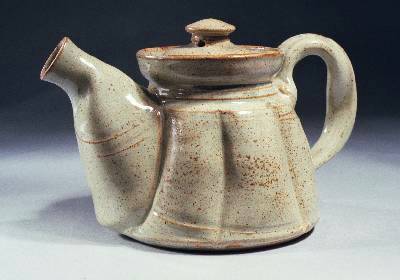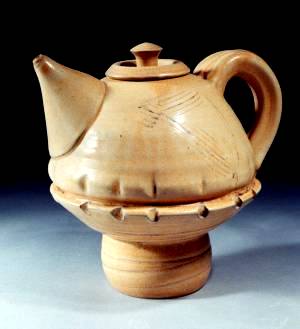
MY START
I found clay after I quit medicine. I was not a mellow retiree looking for a hobby; I wanted a new calling, a new identity. I was taken by clay as soon as I touched it.
It was my good fortune to be introduced to Bill Klock early on. He was the ceramics professor at Plattsburgh State University - a gifted potter with exceptional vision, throwing skill, and a rich background including an apprenticeship with Bernard Leach in 1975.
I was permitted to enroll as an auditing student. Bill Klock created a unique self-guided educational experience for me. I was given a space to work and invited to attend whatever classes interested me. I would learn at my own pace by observation, intuition, experimentation, self-guided study, and relentless practice. I was not really a student, nor was I an apprentice. In private he treated me as a friend or colleague. I volunteered to help out in the studio in any way I could, but I was not required to do anything. I attended most of Bill´s classes. Occasionally, he demonstrated a technique for me that he did not show his regular classes. He rarely watched me work. He offered no opinions or advice on what I was doing (even when I asked him to critique my work). He never coached me. There were no assignments, critiques, tests, or grades.
I studied, practiced, experimented. I began inventing my own tools and ways of doing things. My physical skills and vision were growing. I owned what I had learned. I understood the learning process.

DIGGING IN
Leaving the university setting and moving into my own studio was an important milestone in my journey. It required deeper commitment and more careful scrutiny of what I was trying to accomplish. Working long hours in isolation would lead to greater understanding of myself and my work ... and greater humility. As I have scrutinized my pots and my life, I have continuously re-invented myself and the way I work. The honesty of this process and continual self-renewal has given me a sense of purpose and dignity.
I was a skilled thrower, but I did not like my pots. They were statements about virtuosity, technique, and control - cold, contrived, and overworked. Intuitively, I saw these failings in my work and understood that I must learn to loosen up.
I was amazed to discover that my efforts at loosening up were causing me a lot of anxiety, as if I were trying to make pots before a large audience with my clothes off. It dawned on me that the anxiety was an irrational fear of doing the wrong thing ... and my effort to maintain control was a defense against this anxiety. In order to make good pots, I would need to learn to overcome my fear of failure. I would need to have faith that good things will happen if I have the courage to be more reckless.
I guessed that the best way to lose my anxiety would be to learn to work fast.... so I practiced making the same form all day, day after day, always working as fast as possible. These were athletic exercises but I was pleased to discover that the work I was making was more to my liking. It was more lively, spontaneous and gutsy ... more like the work of the potter I would like to be.
The most interesting lesson that came from my plunge into ceramic recklessness was the realization that my anxiety about failure could be handled better by working quickly than by working slowly: Most of my fast work was ok; a few things were very good; only a few things were bad. I was also pleased that in working fast and avoiding any urge to fiddle, the work was taking on a fresh, unpretentious quality. I was also developing a recognizable, personal style. The "style" is not pre-meditated; it is merely the physical manifestations of my working habits. If you handle the clay in a certain way your pots will look a certain way. I saw that things were starting to fall into place for me ... and working fast was the key.

TOWARD A STYLE AND A PHILOSOPHY
What is good? The body language of the work should grab you on a gut level and tell you that a pot is "good" before you try to analyze why or discover any aspects of the piece that appeal to the intellect. Surface decoration should complement the body language, perhaps add depth of meaning, but never attempt to dominate the viewer´s attention. A vessel should hold secrets, should evoke a sense of mystery and dignity. The work should have a fresh, casual, and confident quality that allows a viewer to accept it as a timeless, otherworldly presence that defines its own standard. Such work springs not from intellectual contrivance, but from the intuition, spirit, and impish recesses of the maker's mind.
I must resist any urge to be fastidious - a habit that sucks the life out of a pot. The object is to create work that is fresh and spontaneous: The only way to make them look that way, is to make them that way.
I must not attempt to plan my work in detail. Too much care, precision, and planning leads to sterile work. It is better that I follow my intuition, play, experiment, invent new tools, new methods ... and be prepared to learn from unexpected results.
I want to do work that is closer to jazz than to classical music. I want it loose, playful, spontaneous, bold. I want to avoid intellectualizing the process as much as possible. I hope to work in such a way that I can regularly be surprised by spontaneous gestures that have a way of popping out of me ... like a "sense of humor".
The qualities of my best work are often the result of a fortunate constellation of crudely orchestrated events. I had a lot to do with it - but in working repetitively with speed and skill, good things often happen without detailed planning. I am thankful for these events.
